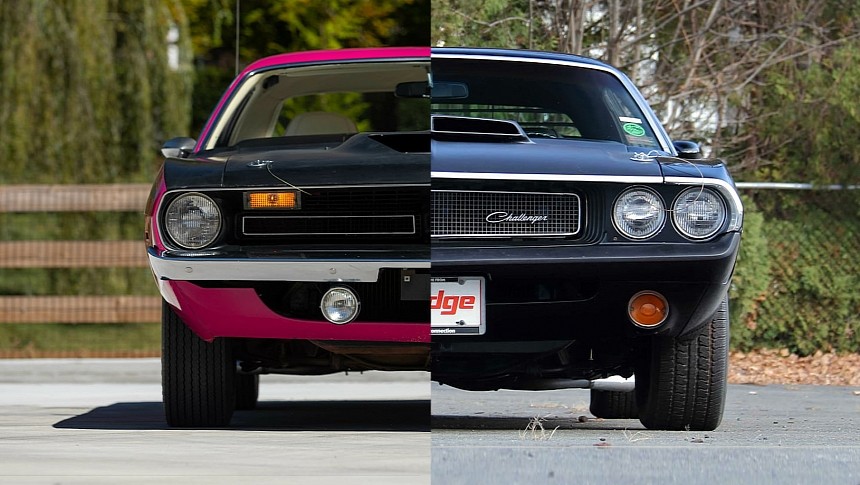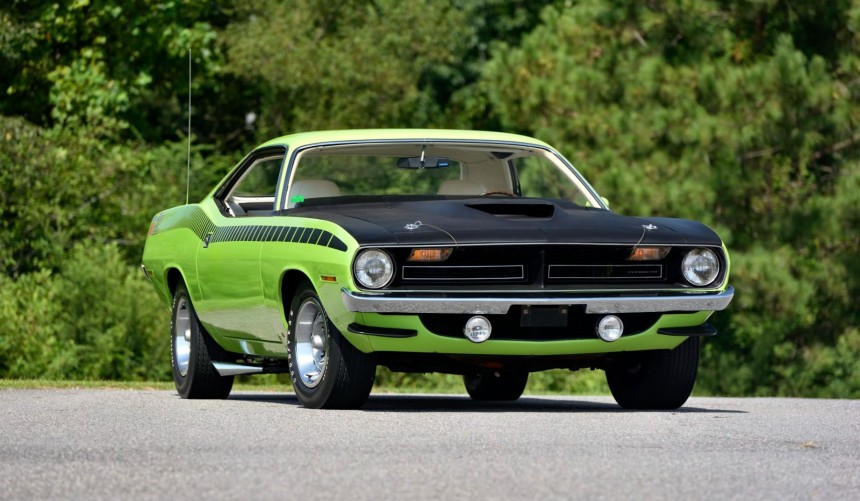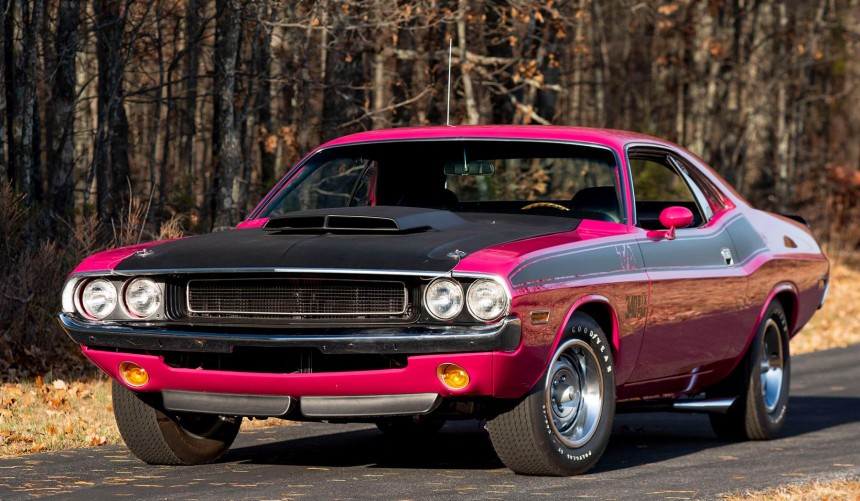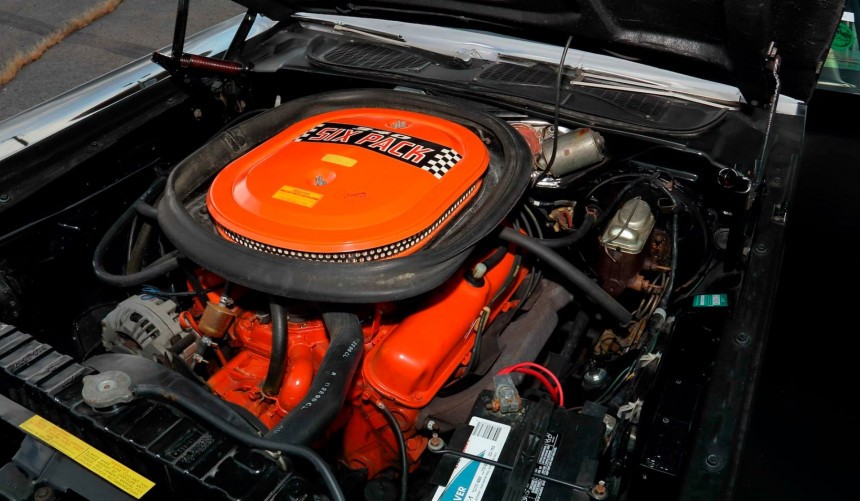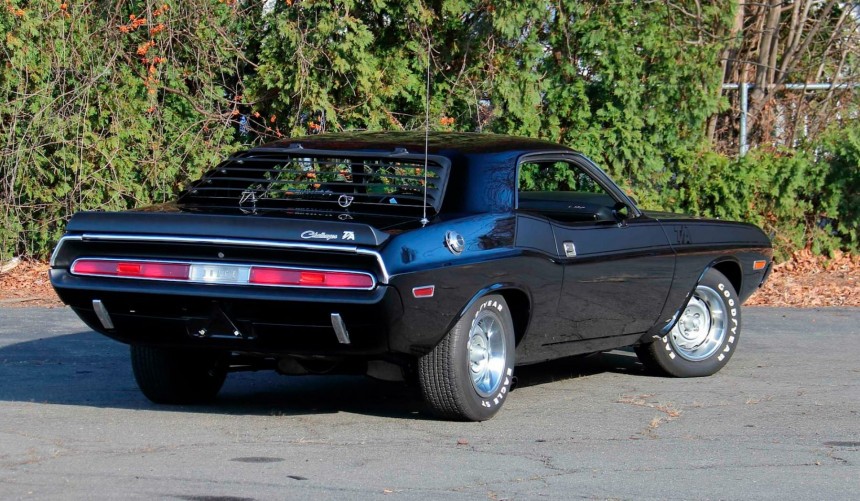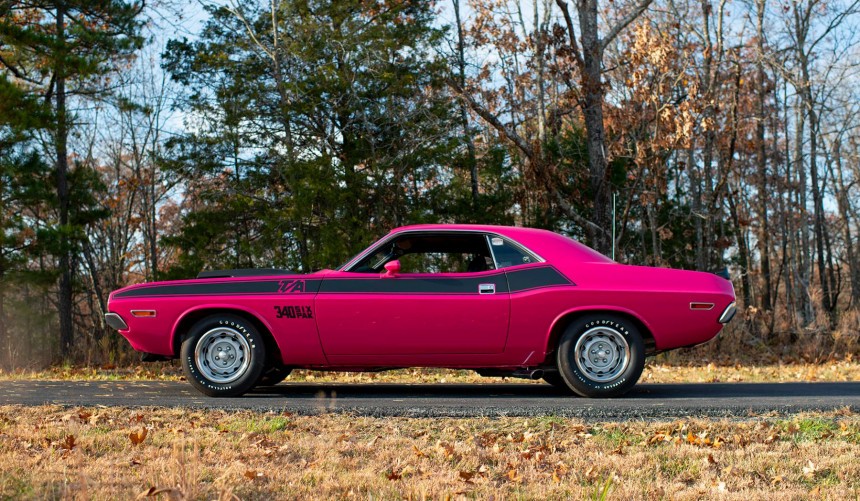Two of the original muscle car era's most exciting homologation specials, these E-body twins became muscle car icons despite not hiding large-displacement V8s inside their engine bays.
The 1970 model year went down as the most exciting of the original muscle car era.
For the first time, all performance-oriented intermediates and nearly all pony cars with the same aspirations (except for the AMC Javelin) were available with 400-plus-cube (6.55+ liters) V8s.
In the Mopar camp, the biggest news was the complete redesign of the Plymouth Barracuda and the introduction of its Dodge-badged E-body twin, the Challenger.
With larger engine bays, both were available with big-block power. Customers could choose one of two 440s (four- or six-barrel carbs) and, for the first time on a fully-street legal Chrysler pony car, the all-conquering 426 HEMI also became an option.
Challengers and 'Cudas equipped with the large-displacement V8s mentioned above became muscle car legends, but two very special editions managed to join them despite having a small-block heart.
The third-generation 'Cuda and the all-new Challenger were both terrific cars but faced strong opposition from Ford's Mustang, Chevy Camaro, and Pontiac Firebird.
To prove that their new models packed a punch beyond the street or drag strip, Plymouth and Dodge decided to enter them in the Sports Car Club of America's Trans Am series.
Similar to NASCAR, where intermediates showcased their potential on high-speed tracks, the Trans-Am series, with its more technical road courses, was the main stage for the lighter, more agile pony cars.
Furthermore, some of the best drivers in the country took part, so the competition enjoyed a great deal of public interest.
Plymouth and Dodge transformed their E-bodies into Trans-Am race cars, but to gain homologation, they had to make the race packages available to the public.
This led to the creation of the Challenger T/A and AAR 'Cuda, two small-block-powered homologation specials that became legends of the golden age of muscle cars.
To compensate for the fewer cubes and horses, the T/A and AAR received a visual makeover that made them look just as aggressive as their big-block-powered siblings.
Available in a series of high-impact colors, the homologation specials released in late March 1970 donned bespoke decal packages that distinguished them from other members of their respective model lines.
Furthermore, both received matte black fiberglass hoods hinged at the rear and held down at the front by two chromed pins.
Both models' hoods featured functional scoops, each with a distinct design. The T/A's had a wider and shorter piece christened "Scat Scoop" by Dodge, while Plymouth designers opted for a narrower yet longer NACA-style version meant to reduce drag.
Another visual cue unique to the Trans-Am specials was their tire setup. With E60x15 Goodyear Polyglas fronts and G60x15 rears, these two models became the first production muscle cars with staggered tires.
In addition to making the models look more aggressive by elevating their tails, the tire setup was used to make room for the side-exiting exhausts that came with big "megaphone" tips.
It's interesting to note that, to avoid legal troubles, the tips left the factory in the trunk of each car and were subsequently installed by the dealerships.
Though the Trans-Am race cars had to abide by a 5.0-liter (305-ci) displacement limit and received special engines based on a de-stroked 340-ci (5.6-liter) block, the street cars were allowed to use a unit that displaced the full 340 cubes.
That being said, the T/As and AAR's 340 were by no means standard. The block featured most of the improvements of the race version, including extra webbing and reinforced main bulkheads that were conceived for (but not equipped with), four-bolt main caps.
The block received heavy-duty internals like forged steel crankshaft and connecting rods, forged aluminum pistons, a milder cam than the one on the race-spec engine, and freer-flowing exhaust manifolds than those of the standard 340.
The highlighting feature was a bespoke intake system based on a high-rise aluminum Edelbrock manifold. It came with a trio of two-barrel Holley carbs hidden underneath a huge oval air cleaner.
Despite its uniqueness, the 340, dubbed Six-Pack (Dodge) or Six-Barrel (Plymouth), was rated at a somewhat modest 290 hp and 345 lb-ft of torque (468 Nm).
Nevertheless, with an aftermarket intake and exhaust manifolds, the Trans-Am derived engine could easily make above 350 horses.
Even in bone stock spec, the 340 delivered max power at 5,000 rpm and the full range of twist as low as 3,400 rpm, which meant that it felt more powerful than it was.
Furthermore, thanks to the weight advantage of the smaller engine, both the Challenger T/A and AAR 'Cuda were mid-to-high-14-second quarter-mile cars right out of the dealership, with the four-speed cars proving faster than those equipped with an automatic.
Straight-line performance aside, the area where the two cars outshined big-block-powered versions was handling.
Again, less weight on the front axle proved an important advantage, but adding a standard Rallye suspension package took maneuverability to a different level.
Comprised of stiffer shocks, high-rigidity rear springs, larger front, and rear anti-roll bars, or torsion bars borrowed from the HEMI-equipped models, the suspension setup made the cars more responsive.
Sure, they didn't handle like Porsches (or any legit sports car, for that matter), but they were unquestionably easier to tame than many big-block-powered muscle cars.
In the 170 Trans-Am series, neither the T/A nor the AAR managed to impress. That led Chrysler to pull the plug on that particular racing program, meaning the two homologation models didn't return for the 1971 model year.
During the single-year production run, Plymouth built 2,724 AARs, while Dodge delivered around 2,400 T/As.
Despite their small-block engines and modest output ratings, these Trans-Am-derived twins are now some of the most sought-after Mopars from the original muscle car era.
A surviving model in great shape usually demands six figures. Since most were delivered with the three-speed A727 Torque-Flite automatic, four-speed manual examples are extremely rare and, thus, fetch a lot more at auctions.
More than five decades after they hit the streets, these fantastic Mopar twins continue to prove that a small-block pony can become a timeless muscle car legend.
If you want to learn more about these icons, we recommend watching the YouTube video below by MuscleCarOfTheWeek.
For the first time, all performance-oriented intermediates and nearly all pony cars with the same aspirations (except for the AMC Javelin) were available with 400-plus-cube (6.55+ liters) V8s.
In the Mopar camp, the biggest news was the complete redesign of the Plymouth Barracuda and the introduction of its Dodge-badged E-body twin, the Challenger.
With larger engine bays, both were available with big-block power. Customers could choose one of two 440s (four- or six-barrel carbs) and, for the first time on a fully-street legal Chrysler pony car, the all-conquering 426 HEMI also became an option.
Challengers and 'Cudas equipped with the large-displacement V8s mentioned above became muscle car legends, but two very special editions managed to join them despite having a small-block heart.
Trans-Am race cars for the street
To prove that their new models packed a punch beyond the street or drag strip, Plymouth and Dodge decided to enter them in the Sports Car Club of America's Trans Am series.
Similar to NASCAR, where intermediates showcased their potential on high-speed tracks, the Trans-Am series, with its more technical road courses, was the main stage for the lighter, more agile pony cars.
Furthermore, some of the best drivers in the country took part, so the competition enjoyed a great deal of public interest.
Plymouth and Dodge transformed their E-bodies into Trans-Am race cars, but to gain homologation, they had to make the race packages available to the public.
This led to the creation of the Challenger T/A and AAR 'Cuda, two small-block-powered homologation specials that became legends of the golden age of muscle cars.
Two of the most aggressive-looking muscle cars of the era
Available in a series of high-impact colors, the homologation specials released in late March 1970 donned bespoke decal packages that distinguished them from other members of their respective model lines.
Furthermore, both received matte black fiberglass hoods hinged at the rear and held down at the front by two chromed pins.
Both models' hoods featured functional scoops, each with a distinct design. The T/A's had a wider and shorter piece christened "Scat Scoop" by Dodge, while Plymouth designers opted for a narrower yet longer NACA-style version meant to reduce drag.
Another visual cue unique to the Trans-Am specials was their tire setup. With E60x15 Goodyear Polyglas fronts and G60x15 rears, these two models became the first production muscle cars with staggered tires.
In addition to making the models look more aggressive by elevating their tails, the tire setup was used to make room for the side-exiting exhausts that came with big "megaphone" tips.
It's interesting to note that, to avoid legal troubles, the tips left the factory in the trunk of each car and were subsequently installed by the dealerships.
Powered by a unique small-block 340
That being said, the T/As and AAR's 340 were by no means standard. The block featured most of the improvements of the race version, including extra webbing and reinforced main bulkheads that were conceived for (but not equipped with), four-bolt main caps.
The block received heavy-duty internals like forged steel crankshaft and connecting rods, forged aluminum pistons, a milder cam than the one on the race-spec engine, and freer-flowing exhaust manifolds than those of the standard 340.
The highlighting feature was a bespoke intake system based on a high-rise aluminum Edelbrock manifold. It came with a trio of two-barrel Holley carbs hidden underneath a huge oval air cleaner.
Despite its uniqueness, the 340, dubbed Six-Pack (Dodge) or Six-Barrel (Plymouth), was rated at a somewhat modest 290 hp and 345 lb-ft of torque (468 Nm).
Nevertheless, with an aftermarket intake and exhaust manifolds, the Trans-Am derived engine could easily make above 350 horses.
Surprisingly fast and sensibly easier to tame
Furthermore, thanks to the weight advantage of the smaller engine, both the Challenger T/A and AAR 'Cuda were mid-to-high-14-second quarter-mile cars right out of the dealership, with the four-speed cars proving faster than those equipped with an automatic.
Straight-line performance aside, the area where the two cars outshined big-block-powered versions was handling.
Again, less weight on the front axle proved an important advantage, but adding a standard Rallye suspension package took maneuverability to a different level.
Comprised of stiffer shocks, high-rigidity rear springs, larger front, and rear anti-roll bars, or torsion bars borrowed from the HEMI-equipped models, the suspension setup made the cars more responsive.
Sure, they didn't handle like Porsches (or any legit sports car, for that matter), but they were unquestionably easier to tame than many big-block-powered muscle cars.
The Challenger T/A and AAR 'Cuda today
During the single-year production run, Plymouth built 2,724 AARs, while Dodge delivered around 2,400 T/As.
Despite their small-block engines and modest output ratings, these Trans-Am-derived twins are now some of the most sought-after Mopars from the original muscle car era.
A surviving model in great shape usually demands six figures. Since most were delivered with the three-speed A727 Torque-Flite automatic, four-speed manual examples are extremely rare and, thus, fetch a lot more at auctions.
More than five decades after they hit the streets, these fantastic Mopar twins continue to prove that a small-block pony can become a timeless muscle car legend.
If you want to learn more about these icons, we recommend watching the YouTube video below by MuscleCarOfTheWeek.
